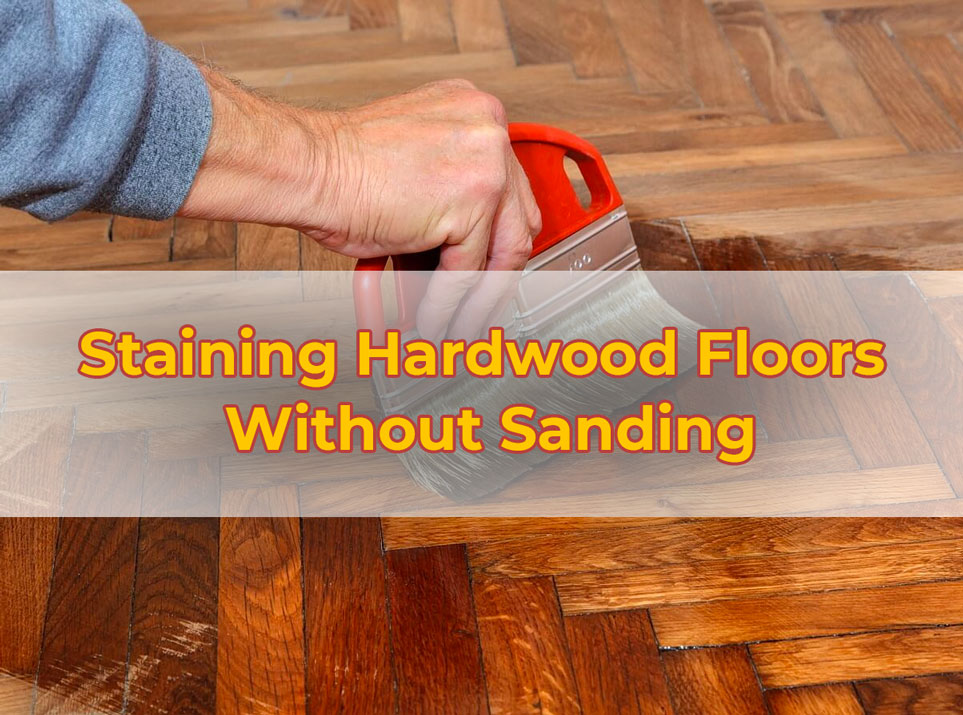Looking for alternatives way staining hardwood floors darker without sanding? Staining hardwood floors is a perfect way to enhance their look, but traditional methods often require sanding down the surface before the stain is put on. But, not everyone has the resources or enthusiasm to do this.
Years ago, homeowners didn’t have many options to stain their hardwood floors darker without sanding. The only answer was to sand the surface before applying new stain. But, as time passed, products that saved time and effort became available, such as chemical strippers and gel stains.
So if you are attempting to revive the look of your old hardwood flooring or just want to try a darker color, there are options that don’t require extensive sanding. With the correct tools and techniques, you can make your hardwood floors a beautiful focal point in your home.
Why Staining your Hardwood Floors?

Staining your hardwood floors can greatly enhance the overall aesthetic appeal of your home. By adding color to your floors, you can create a warm and inviting atmosphere that complements your interior design.
Staining hardwood floors serves several purposes and can be beneficial for various reasons:
1. Enhancing the appearance
When it comes to enhancing the appearance of your home, staining your hardwood floors can make a world of difference. Not only does staining give your floors a fresh and updated look, but it also helps protect them from daily wear and tear. With a wide range of stain colors available, you can choose the perfect shade that complements your home’s décor.
Staining hardwood floors not only enhances their aesthetic appeal but also adds depth and character to any room. By choosing a darker stain color, you can create a warm and inviting atmosphere, while lighter stains can brighten up smaller spaces. Furthermore, staining helps bring out the natural grain and beauty of the wood, creating an elegant and timeless look that will impress your guests.
2. Color consistency
One of the main reasons for staining your hardwood floors is achieving a desired color tone. Wood species naturally vary in color, which means that even if you have selected the same type of wood for your entire flooring project, there may still be noticeable differences in shade.
By applying a stain, you can create a more uniform look by blending these variations and achieving the exact color you desire.
3. Protection and durability
By applying a stain, you can create a barrier that helps prevent scratches, spills, and other types of damage from penetrating the wood. This is especially important in high-traffic areas such as entryways or living rooms where foot traffic can cause significant damage over time.
Additionally, stains offer resistance against fading caused by sunlight exposure, keeping your floors looking vibrant for years.
4. Restoring and rejuvenating old floors
If you have older hardwood floors or Signs of Mold Under Hardwood Floors that have faded or become worn over time, staining can breathe new life into them. It can revitalize the appearance of the wood, making it look fresh and vibrant again.
5. Personalization and customization
Staining hardwood floors allows homeowners to personalize their living spaces. Whether you prefer a light, natural look or a dark, rich color, staining provides the opportunity to create a floor that reflects your individual style and complements your home’s decor. Check also: Why Is Kilz Not Recommended For Flooring?
Methods of Staining Hardwood Floors Without Sanding

Staining hardwood floors without sanding is a great way to upgrade and troubleshoot their look without the labor-intensive process of sanding. Here’s how:
1. Chemical stripping
When it comes to revitalizing worn-out hardwood floors, sanding has often been regarded as the go-to method. However, for those seeking an alternative solution that is more time-efficient and less labor-intensive, chemical stripping emerges as a game-changer in the world of floor restoration.
By utilizing powerful chemicals specifically designed to dissolve varnishes and stains, homeowners can achieve stunning results without the hassle of sanding.
One significant advantage of chemical stripping is its ability to preserve the natural beauty and integrity of hardwood floors. Unlike sanding, which involves removing a layer of wood from the surface, chemical stripping dissolves only the existing finish or stain.
This means that homeowners can enjoy their original flooring without compromising its thickness or structural stability.
2. Deep cleaning
Thoroughly clean the hardwood floors using a hardwood floor cleaner to remove any dirt, grime, or wax buildup. Ensure the surface is dry and free from any residue before applying the stain.
While this method won’t open up the wood pores as effectively as sanding, it can help improve stain absorption to some extent.
3. Liquid deglosser
With this miraculous product, you can achieve a stunning stained finish without the need for time-consuming sanding.
Liquid deglosser works by chemically removing the glossy surface layer of your hardwood floors, allowing the stain to penetrate deeply and evenly. This innovative solution cuts down on both time and effort while still providing professional-looking results.
Simply apply the liquid deglosser with a cloth or sponge in small sections, working in one direction to ensure an even application. Allow it to sit for a few minutes before wiping away any residue – then get ready to witness the transformative power of this game-changing product.
4. Gel stain
Gel stain is a revolutionary solution for homeowners seeking to restore and update their hardwood floors without the hassle of sanding.
Traditionally, refinishing hardwood floors involved labor-intensive sanding to remove the existing finish and reveal a fresh surface for staining. However, with gel stain, this time-consuming step can be bypassed altogether, saving both time and effort.
By using gel stain on hardwood floors, homeowners can achieve professional-level results with minimal preparation. Unlike traditional stains that penetrate deep into the wood fibers, gel stains sit on top of the surface, allowing them to be applied directly over existing finishes.
This eliminates the need for sanding as the gel stain effortlessly adheres to most types of finishes including varnish, polyurethane, or even wax.
5. Tinted polyurethane
This innovative product provides an efficient and convenient solution for those looking to transform their hardwood floors with minimal effort.
One of the key advantages of using tinted polyurethane is its ability to enhance the natural beauty of wood while adding color and depth.
Unlike traditional stains that only sit on top of the wood surface, this specially formulated polyurethane seeps into the pores, creating a durable and long-lasting finish. Check also: How to Repair Swollen Laminate Flooring without Replacing.
Preparing the Hardwood Floors
Ready to get your stain-on? Follow these six steps for a successful transformation:
- Clear the room: Move furniture and rugs out of the way.
- Clean the floors: Vacuum and sweep. For extra sparkle, use a wood floor cleaner and mop.
- Repair any damage: Check for scratches, dents, or loose boards. Use wood filler or replace boards.
- Spot sand: Use fine-grit sandpaper for rough areas.
- Apply pre-stain conditioner: To ensure an even color.
- Mask off edges: Painter’s tape protects walls and baseboards.
Pro tip: Use a brush or foam applicator pad for precise results. Now you’re ready to give your hardwood floors a fresh new look without sanding!
Maintenance and Care Tips

To maintain hardwood floors and keep them looking lovely, here’s what you need to do:
- Clean often! Vacuum or sweep with a soft-bristled broom.
- Protect them – use felt pads on furniture legs and area rugs in high-traffic areas. Don’t drag heavy objects across the floor.
- Wipe up spills with a damp cloth or mop. Dry any wet spots too. Use mats near entryways to catch dirt and moisture.
- Control humidity – use a humidifier during dry seasons and dehumidifier during humid seasons.
Be careful with cleaners and abrasive materials – they can damage the finish. Use products made for wood floors. Have your floors deep-cleaned by professionals every few years for best results.
Good luck – with these tips, you’ll be able to enjoy your hardwood floors for years! Check also: Gap Between Tub and Floor.
Can hardwood floors be stained darker?
The answer is yes, hardwood floors can indeed be stained darker. Staining allows you to change the color of your existing hardwood floors, giving them a fresh new look without having to replace them entirely. Whether you have light-colored oak floors and want to transform them into a rich espresso shade or wish to deepen the tone of your dark walnut floors, staining provides endless possibilities for customization.
However, it’s important to note that achieving a darker stain on hardwood floors involves more than simply applying a darker-colored stain over the existing finish. Before proceeding with staining, thorough preparation is crucial. This typically involves sanding down the current finish of the floor, which removes any previous stains or coatings and exposes bare wood.
Is it better to stain hardwood floors light or dark?
Both options have their own unique benefits and considerations. Light stains are often chosen to create an open and airy feel in a space. They can help make rooms appear larger and brighter, making them ideal for smaller spaces or areas with limited natural light. Light stains also tend to show less wear and tear over time, as scratches and dents are less noticeable on lighter surfaces.
On the other hand, dark stains bring a sense of richness and elegance to any room. They can add depth and warmth, creating a cozy atmosphere that is perfect for larger spaces or formal settings. Dark stained floors also have the advantage of hiding dirt and debris more effectively than lighter ones, making them easier to maintain in high-traffic areas or households with pets or children.
How long does stain last on hardwood floors?
In general, stains on hardwood floors can last anywhere from a few years to decades if properly maintained. Water-based stains tend to have a shorter lifespan compared to oil-based ones.
Water-based stains are more prone to fading over time and may require reapplication every 3-5 years.
On the other hand, oil-based stains penetrate deeper into the wood fibers and offer better durability, lasting up to 10-15 years before needing recoating.
Can you sleep in house after staining floors?
The good news is that it is generally safe to sleep in a house after staining floors, but there are a few important factors to consider.
Firstly, it’s crucial to ensure proper ventilation before and during the staining process. Staining floors can release fumes that may be harmful if inhaled excessively. To minimize exposure, open windows and use fans or air purifiers to circulate fresh air throughout the space.
Additionally, make sure all doors leading to other rooms are closed during staining and for several hours afterward.
Another key consideration is the type of stain used. Water-based stains tend to have lower levels of volatile organic compounds (VOCs) compared to oil-based stains.
“There is no real ending. It’s just the place where you stop the story.”






